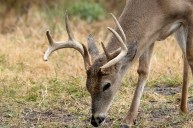Every hunter knows mule deer, whitetail deer, and other members of the deer family shed their antlers once a year. Moose, elk, caribou, and many others go through this process. For deer, it usually takes as little as 24-48 hours for the antlers to actually fall off, but the shedding process takes between two to three weeks and then new antlers will regenerate throughout the summer. Most also know deer shed their antlers anywhere between January and April, sometimes earlier or later depending on the age of the deer, the physical condition it is in, and where it lives. However, few hunters have stopped to look at exactly why the antler shedding cycle happens every year, and the natural causes behind it. It's really quite fascinating once you dive into the way the animal's body begins growing antlers, and why the process comes to a screeching halt once the breeding season arrives before repeating all over again in the early spring.
How and Why They Shed

Travis Smola
Deer antlers are made up of a honeycomb, bone-like tissue. The mounting point where the antlers attach to the head is called the pedicle, where they break off. The next time you pick up a shed antler, feel the surface of the pedicle. That rough texture is basically what's left of the connective bone tissue between the antlers and the animal's head.
During the summer, the antlers grow fast for about two to four months. High levels of testosterone slow the growing speed and the veins and arteries around the velvet cut the previously heavy nutrition and blood supply to the antlers. Once that happens, the velvet encasing the antlers starts to wither and falls off. It's likely the velvet irritates the deer to some degree after that, spurring them to rub their new set of antlers on a tree to remove the velvet. This usually happens in mid or early September.
For most deer in North America, once the rut is over, a buck's testosterone levels drop significantly. The dropped hormone level activates specialized cells called osteoclasts. These cells eat away at the pedicle resulting in deer antlers to become weak to the point they come loose and fall off. Once they hit the ground, nothing goes to waste in nature. The dropped antlers act as a calcium source for many small animals who gnaw away at the dropped bone until it disappears completely.
Contributing Factors

Travis Smola
In truth, it's hard to determine when a male deer may lose his antlers. Some deer shed their antlers earlier. Some may do it later than normal. The timing seems to depend on many different factors. Wounded or injured deer usually cast their antlers earlier than normal because injuries activate the osteoclasts cells early.
Deer that are in good condition, live in a mild climate, and have a high-quality habitat might keep their antlers well into the spring months. Deer with poorer conditions, live through harsh winters, and have limited nutrition based on their habitat often shed their antlers earlier. Sometimes the mating season runs long if all the female deer are not bred by December. This can result in a delay of that drop in testosterone we mentioned earlier, and can also delay the activation of the osteoclasts that start the shedding process.
Sometimes a late season hunt can result in a trophy with no antlers because antlers have already been shed. So, before you pull the trigger, look for any red, raw, or scabbed-over areas on either side of the forehead to determine if you're shooting a buck that has already shed his antlers. Likewise, be careful when grabbing the antlers of a buck shot late in the season. More than one hunter has been surprised to have the antlers pop off when they grabbed them!
The late winter and springtime are the ideal times to head out in the woods and start shed hunting. Set up a trail camera to help determine when they are dropping. Finding sheds is a great way to scout for the next whitetail deer hunting season because you'll have physical proof in your hands that a deer survived the season. Then you can start making plans to hunt him the following fall.
READ MORE: WHY YOU SHOULD KEEP AN EYE OUT FOR SHED ANTLERS ALL YEAR-ROUND




